A Top-Notch Wordsmith, and a Master of Speculative Fiction: The Best of John Brunner
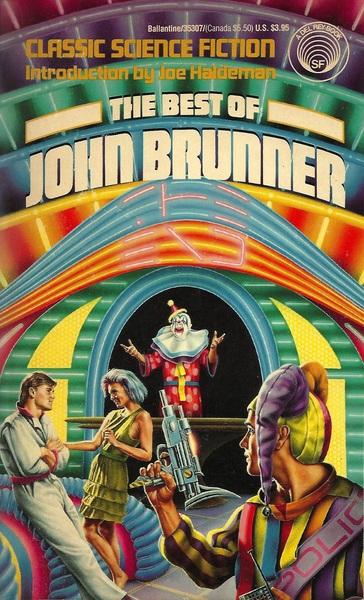 |
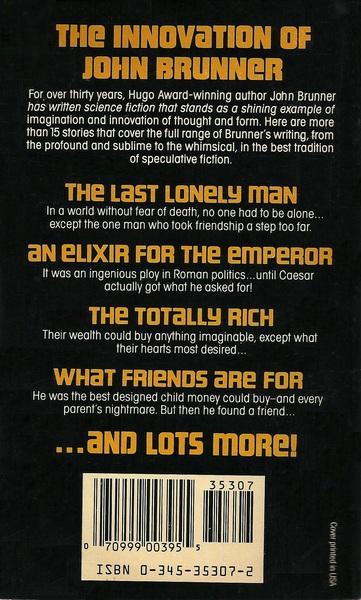 |
The Best of John Brunner (Del Rey, 1988). Cover by Barclay Shaw
After several years, I’m finally gotten to the last of the Del Rey Classic Science Fiction Series! The Best of John Brunner was published in 1988. But is this book even part of that series? The previous installment, The Best of James Blish was published 9 years earlier. And though The Best of John Brunner is indeed a Del Rey publication, and it says “Classic Science Fiction” on the cover, the cover design is much different, including the font, from earlier editions.
However, in this post, I’ll treat it as the twenty-second and last installment of the Del Rey Classic Science Fiction Series. (Heck, even John O’Neill didn’t know this volume existed until a few years ago.)
A few of Brunner’s paperback releases during his four-decade career
Since I first started this series, about five years ago (sorry it’s taken so long; full-time academia is actually full-time), I knew that I had more of a bent towards fantasy and horror as opposed to science-fiction proper. My reading through this series confirmed this. But! I’ve also learned that there is indeed a sort of science-fiction that I do gravitate towards, and it tends to be science-fiction written in the 1960s and later: authors such as Philip K. Dick, Joe Haldeman, Roger Zelazny, and I can now include John Brunner.
Don’t get me wrong, some of the earlier writers I also ended up really loving, such as Stanley Weinbaum, Henry Kuttner, C.M. Kornbluth, Fritz Leiber (and of course Robert Bloch), and the later stories by James Blish.
But why am I more attracted to this later science fiction? I think John Brunner captures it well in a 1972 interview, when he noted that early science-fiction tended to deal with the “sheer wonderment at the infinite possibilities of applied technology” while later science-fiction increasingly “consisted in the examination of the impact of technological change on the human personality.” That’s a very insightful comparative observation, and one that I think pretty well explains my likes and dislikes in reading the Del Rey Classic Science Fiction Series.
Also, for me, later science-fiction, like Brunner’s, often feels like it was written today, whereas the earlier science-fiction can sometimes seem very dated, sometimes because the focus is technology. I remember reading Robert Heinlein’s The Moon is a Harsh Mistress a few years ago, a very good novel, and I rarely thought about the age of this book because it was so well written. But, sometimes, Heinlein’s story felt dated when he had his futuristic characters stop at phone booths to make calls. (!)
But this is more than just a complaint of overly-simplistic scientific or technological ideas. As Brunner noted, later science-fiction is primarily a change in focus: a focus upon human beings and how technology can change them. That I find very interesting.
Returning to The Best of John Brunner, the engaging cover design was done by Barclay Shaw (1949–) with the introduction by the well-known science fiction writer Joe Haldeman (1943–). John Brunner (1934–1995) is probably most famous for his Stand on Zanzibar (1968), which won the 1969 Hugo and Nebula and often makes the lists of greatest science fiction of all time. But he wrote many other short stories and novels.
Haldeman notes in the introduction that about half the stories in The Best of John Brunner are heavy fare and the other half fairly light. It turned out that I wasn’t as interested in the “light fare,” though some of these were inventive and humorous. For example, there were four different very short stories modeled on consumer reports but of futuristic devices, such as time machines and wishing devices. There are bits of enjoyable satire in these stories.
But, by far, I think the “heavy fare” was much more engaging. There were several tales that fit this description, such as “The Totally Rich.” It focuses on one Derek Cooper, who has invented a device for duplicating things. You find out that he, and his research, have been somewhat manipulated by a super-wealthy patron who has hopes for what the “Cooper Effect” might be able to end up duplicating. In the course of the story, you find out that the small town where Derek was working, and the people who lived there, were all props in order to give him a quiet and conducive environment to work. As the story progresses the hopes of the “totally rich” patron are revealed, as well as the limits of Cooper’s “Effect.” The story emerges as a subtle commentary on the effects of new technology on love and death, with some bitter irony at the end.
Another excellent but “heavy fare” was “Vitanuls,” set in the not-too-far future when over-population is rife on Earth but medical technology has soared. The story starts in an East Indian baby delivery ward. A visiting American doctor, Dr. Chance, from the World Health Organization is observing the sacrificial efforts of one Dr. Ananda Kotiwala on Kotiwala’s last day before retirement. Kotiwala is about to retire to become a sunnyasi, a sort of eastern holy man. Chance can hardly hold back his disgust and pity for such a waste of medical talent.
But Kotiwala suspects something is wrong with the last baby he helps to deliver. The baby is examined and nothing appears immediately wrong, though the experienced Kotiwala suspects otherwise. The story then fast-forwards to several years later. Kotiwala has been traveling about from village to village helping poverty-stricken people with as much medical help as he can provide in his new and meager circumstances. A helicopter, with Chance aboard, has tracked Kotiwala down in some very remote Indian location. It turns out that Kotiwala was correct; something was wrong with that baby, and the same condition has been found in babies throughout the world since then — a quickly growing epidemic. It turns out that almost all recent newborns are “vitanuls.” You’ll have to parse out the Latin roots to figure out what might be wrong with those babies here. But it turns out that certain Hindu beliefs, which Kotiwala holds, come out true. When the reality of the situation hits the American doctor:
For a few seconds Chance imagined that he heard the hollow laughter of demons in the whisper of the winter wind. With a violent effort he rid himself of the delusion. (p. 287).
In sum, Brunner suggests in “Vitanuls” that over-population and the rise of medical technology may have some unintended and very unwanted consequences and we should re-think the purposes and long-term goals of both reproduction and medicine. Brunner also implicitly suggests that some religious ideas and superstitions may have more wisdom than modern science recognizes.
These sorts of themes re-emerge in various other stories, such as the tellingly-entitled “The Suicide of Man.” This story is difficult to summarize but it’s basically about a man being “resurrected” (of sorts) centuries in the future by human beings so evolved from us that they really count more as aliens. One particular passage, I thought, shows Brunner’s skill at presenting deeply psychological and complicated ideas in compelling and understandable ways. The main character has the following inner dialogue:
He was used to taking for granted he was somebody. It was a measure of the success [of his resurrectors] that he should have gone on believing, or rather not worrying about, this aspect of his nature until now. He must, he realized, correspond in minute detail to the version of [his former self] who, aeons ago, had discovered that he was due to die of cancer and preferred to choose his own moment and his own way to leave the world. But he was-not that person. He-now was not some body. He was some one.
(pgs. 264–5)
It is hard to pick a favorite in the Del Rey Classic Science Fiction Series. Different writers have different charms. But I have to say, for me, The Best of John Brunner is probably near the top, if not first. Brunner is a top-notch wordsmith, and a master of the written tale, in general. And most important to me, his engagement with science-fiction really shows the different and exciting directions that it can go. Brunner is a prime example of how the science-fiction moniker was progressively being called “speculative fiction” during his lifetime. I highly recommend The Best of John Brunner.
Here’s the complete Table of Contents:
Introduction: The Brunner Mosaic, by Joe Haldeman
“The Totally Rich” (Worlds of Tomorrow, June 1963)
“The Last Lonely Man” (New Worlds SF, #142 May-June 1964)
“Galactic Consumer Report No. 1: Inexpensive Time Machines” (Galaxy Magazine, December 1965)
“Fair” (New Worlds Science Fiction #45, March 1956)
“Such Stuff” (The Magazine of Fantasy and Science Fiction, June 1962)
“Galactic Consumer Report No. 2: Automatic Twin-Tube Wishing Machines” (Galaxy Magazine, June 1966)
“Tracking with Close-ups (21) and (23) (excerpt from Stand on Zanzibar)
“X-Hero” (Omni, March 1980)
“No Future in It” (Science Fantasy, September 1955)
“Galactic Consumer Report No. 3: A Survey of the Membership” (Galaxy Magazine, December 1967)
“What Friends Are For” (Fellowship of the Stars, 1974)
“The Taste of the Dish and the Savor of the Day” (The Magazine of Fantasy and Science Fiction, August 1977)
“Galactic Consumer Report No. 4: Thing-of-the-Month Clubs” (Galaxy, January 1969)
“The Man Who Saw the Thousand-Year Reich” (The Magazine of Fantasy & Science Fiction, November 1981)
“An Elixir for the Emperor” (Fantastic Stories of Imagination, November 1964)
“The Suicide of Man” (Isaac Asimov’s Science Fiction Magazine, July-August 1978)
“The Vitanuls” (The Magazine of Fantasy and Science Fiction, July 1967)
The Best of John Brunner was published in November 1988 by Del Rey Books. It is 300 pages in paperback, originally priced at $3.95. The cover is by Barclay Shaw. It is out of print. There is no digital edition.
19 volumes of the Ballantine Classics of Science Fiction (missing Weinbaum, Del Rey, and Brunner)
Our previous coverage of the Classics of Science Fiction line includes (in order of publication):
- The Best of Stanley Weinbaum by James McGlothlin (1974)
- The Best of Henry Kuttner by James McGlothlin (1975)
- The Best of Cordwainer Smith by James McGlothlin (1975)
- The Best of C. L. Moore by James McGlothlin (1976)
- The Best of Frederik Pohl by James McGlothlin (1976)
- The Best of John W. Campbell by James McGlothlin (1976)
- The Best of C. M. Kornbluth by James McGlothlin (1977)
- The Best of Philip K. Dick by James McGlothlin (1977)
- The Best of Fredric Brown by James McGlothlin (1977)
- The Best of Edmond Hamilton by Ryan Harvey (1977)
- The Best of Leigh Brackett by Ryan Harvey (1977)
- The Best of Robert Bloch by James McGlothlin (1977)
- The Best of Murray Leinster by James McGlothlin (1978)
- The Best of L. Sprague De Camp, by James McGlothlin (1978)
- The Best of Jack Williamson by James McGlothin (1978)
- The Best of Raymond Z. Gallun by James McGlothlin (1978)
- The Best of Lester del Rey by Jason McGregor (1978)
- The Best of Eric Frank Russell by James McGlothlin (1978)
- The Best of Hal Clement by James McGlothin (1979)
- The Best of James Blish by James McGlothin (1979)
- The Best of Fritz Leiber by James McGlothlin (1979)
- The Best of John Brunner by John O’Neill (1988)
See all of our recent Vintage Treasures here.
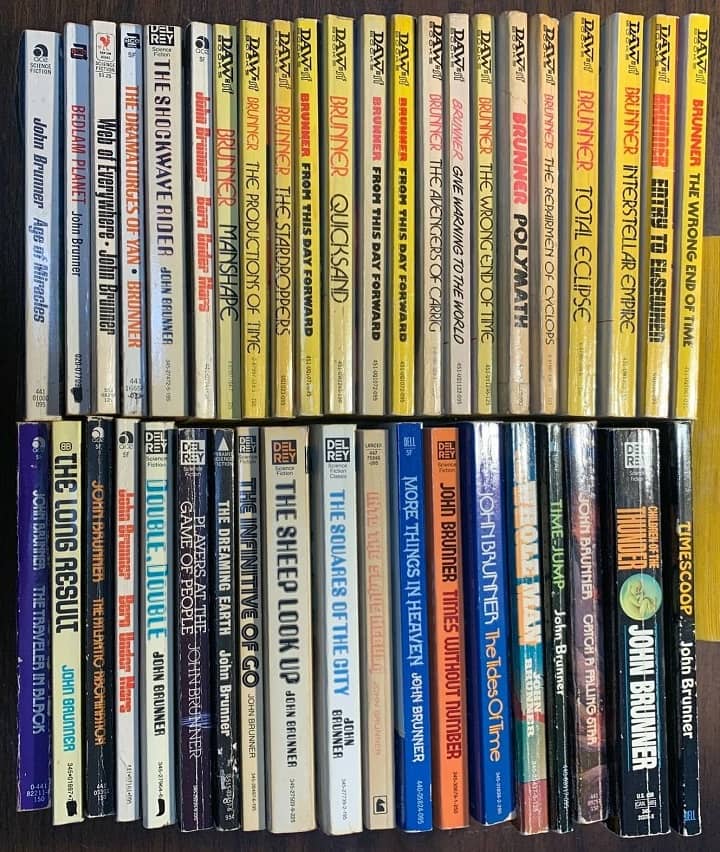
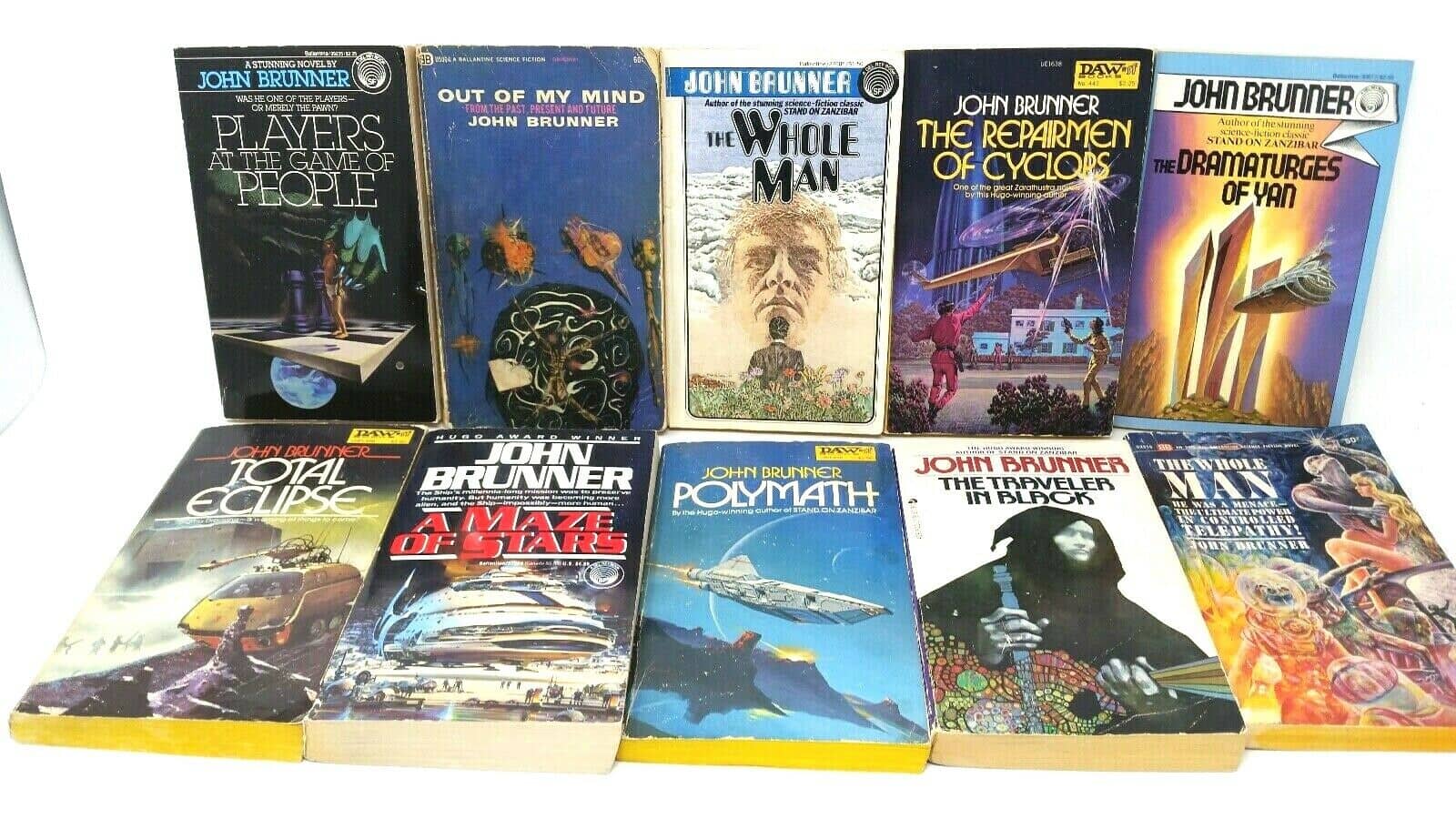
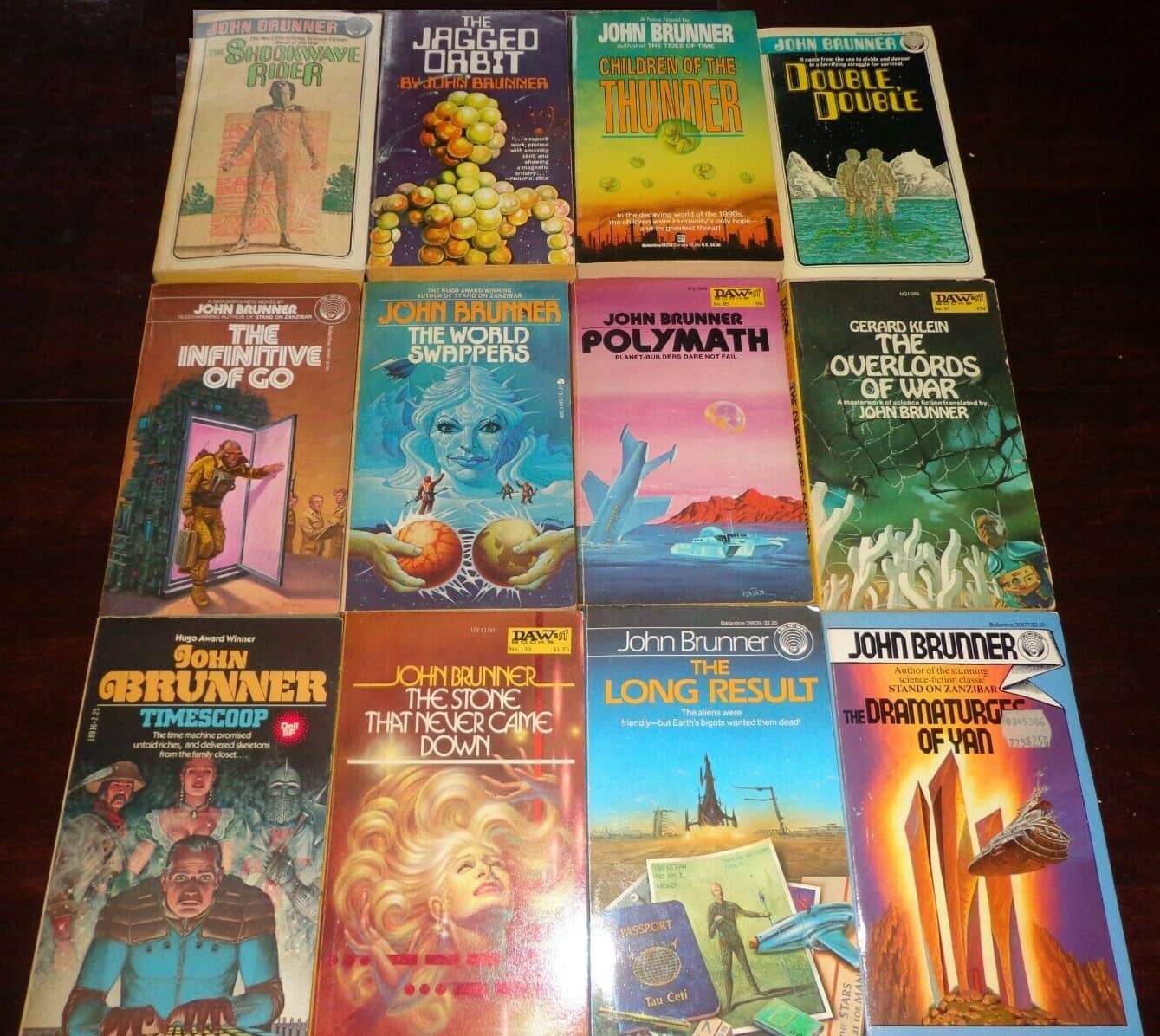
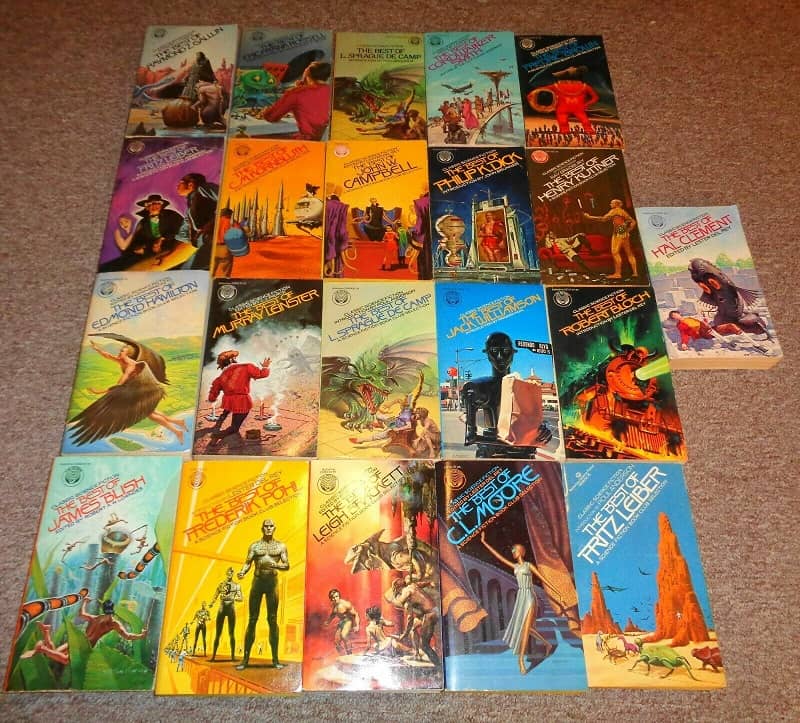
I’ve read a lot of John Brunner books – of his minor works “The Traveller in Black” which I think is supposed to be his one foray into fantasy vs Sci-Fi is my favorite. I’ve read a collection of others from “interstellar Empire” to “Jagged Orbit”…
I think his major 3 works should have some modern re-discussion though; Shockwave Rider, Sheep Look up and Stand on Zanzibar. Even the “Extra Credits” people did one on the latter – too many trends predicted decades ahead of time for an author more or less dismissed in his time as a mere entertainer.
He’s one of the many late era authors (I hate the “new wave” term) I enjoy and one of the big reasons I’m against re-makes and sequel/prequels for movies- if we could force Hollow-Wood to drop that crutch a decade I can imagine some producer milling through the used bookstore and picking up some of his books – then after sitting down and reading one cover to cover (and shocking himself checking the publication date) calling Brunner’s estate for movie rights…
I would love to see some movies based on Brunner’s stories. Maybe it will happen some day.
It can happen if we spread the call to boycott the “Re-Make” culture. (re-boot, re-launch, sequel or prequel to a long dormant franchise) Look at MOTU – both revelation and 3DCG animated. Cheap stories meant to chew it up, spit it out, de-construct and “Give . us . MONEY” but does nothing good for the franchise and wounds the memories of past. I’d rather “Rulers of the Omniverse” – the background movie (obviously MOTU but…) in Concrete’s “Fragile Creature” story – or even Kaptara – a comic book that both parodied but played loving tribute to MOTU and Saturday morning cartoons. Main character is gay, I don’t care. Animated or (heh) Live Action it’d be a fun ride and not butcher childhood memories –
There’s also a practical means to this – note this board is full of authors, old authors, fans of works from the golden age but mostly 60s to 80s fantasy + sci-fi publications… If there’s a choke-out on the ‘re-make’ just sending Cousin Louie to the Xerox machine does NOT work as a “Writer” – nor does getting a supposedly established talent to nail their name to Xerox copies. Nothing to stand on it sinks or swims. An existing copy they can hype up then have it sink and make money doing it… (Margin betting) – but a new one sinks or swims and it’s not easy to fail it deliberately and run away with more money than put in.
Therefore a NEW (not yet adapted) project has to be a good story with a good writer. Ideally the old one is still alive, given much creative freedom and extra pay (vs just selling movie rights) to work with the Director and scriptwriter. If the author’s long dead get a current good writer to help this process. IMO the Conan movie with Arnie in it is the best. REH didn’t write too many “Movie length” stories on Conan and those he did were for Conan fans already – the movie did the best to combine elements and make a tribute to the character and genre. In simplistic terms they got a pro team, threw money at the project and let them work on their resume for their next gig. Later works it was a BIG property and too many cooks messed with the soup which is the norm. Later they did the same to re-boot the “My Little Pony” franchise but because it was considered bottom of the barrel let a small team of pros work on it and it transcended the original.
John didn’t know this book existed until a few years ago? Wow. I’ve had a copy for I forget how many years but haven’t read it yet. It’s the only one I’ve not read. Like you, I’m not sure if it should be considered part of the series because of when it was published, but I do include it. Too bad Ballantine didn’t reboot the series with further volumes.
And you’re wrong about full time academia being full time. It’s more than full time. (Which is why I still haven’t written that review John asked me for at the beginning of the summer.)
Definitely more than full time, especially since I have administrative duties as well now!
Have you seen this new collection?
https://locusmag.com/2021/02/paul-di-filippo-reviews-the-society-of-time-by-john-brunner/
Thanks for the link! I was unaware of this.